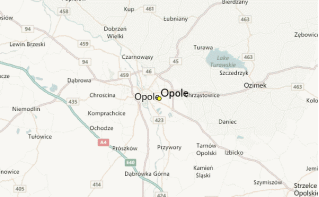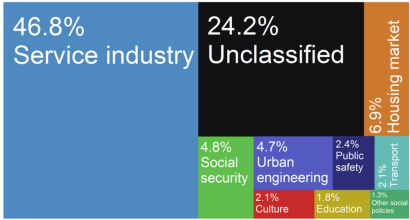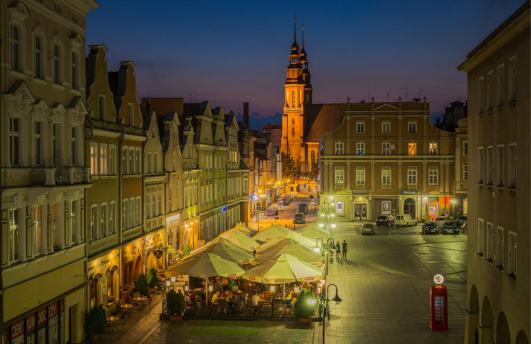Opole- Upper Silesia 作者: 来源: 发布时间:2021-03-05
Ⅰ. Population and Area
Population (31 December 2019)
• City 128,035 Decrease (27th)
• Metro 267,000
Country Poland
Voivodeship Opole
County city county
Area: 37.28 sq miles
Website https://www.opole.p
Ⅱ.Natural Geography (environment and resources)
- Opole is a city located in southern Poland on the Oder River and the historical capital of Upper Silesia. With a population of approximately 128,035 (December 2019), it is the capital of Opole Voivodeship (Opolskie province) and the seat of Opole County. With its long history dating back to the 8th century, Opole is one of the oldest cities in Poland. It is also the smallest city in Poland to be the largest city in its province.
- Opole, the capital of the Opolskie voivodship, is a medium sized city of 125,000 and coverings a total area of 96 km2. It is located in the south-western part of Poland, on the river Oder as it crosses the Slaska Plain. As a consequence, the region can be described as typical agricultural lowlands.
- Its position in the open valley of the river Oder gives Opole a mild climate characterised by low temperature variations and a small amount of rainfall. The average annual temperature is 8° Centigrade, and the winters are very short and mild while the summers are long with warm days. These climatic conditions encourage outdoor sports and recreational activities.
- Transport
- Opole is the voivodeship capital with a population of 128,000, located in Southern Poland near the Czech Republic (54 km away from the border) and Germany (240 km). The population of the entire agglomeration is estimated at 320,000, and the neighbouring gminas closely cooperate with the city economically, as well as by improving education standards and creating new jobs.

- The city features convenient and fast railway network whose density is twice as high as the national average. River transport is also used extensively. Two river ports are situated on the banks of the Oder river on the territory of the gmina, featuring dock basins, railroad sidings and gantry cranes for cargo weighing up to several hundred tonnes. The city has great road access, the most important road being the international Dresden-Kiev motorway – the A4. If you opt to use it, teaching the nearest international airports in Wrocław (approx. 100 km) and Katowice (110 approx. km) takes less tan an hour. In addition, the Kamień Śląski airport, located only 24 km away from the city centre, accommodates air taxis and connections outside regular air traffic.
- A robust public transport system is also present, adapted to the needs of investors both in regard to where new stops are situated and the frequency of buses. The public bicycle system has also been growing, and 35% of all roads in Opole are traffic-calming areas and bicycle lanes (124 km).
- Modern-day Opole harmoniously blends tradition and modernity, as well as business and science. It is also a university city where innovative projects come to life, benefiting domestic and international companies.
- About Opole | Miasto Opole https://www.opole.pl/en/dla-inwestora/about-opole
Ⅲ.Economy
- Opole is the Opole Voivodeship's centre for commerce, banking, industrial complexes and other major service sector industries
- Prior to World War II, due to major limestone deposits in Opole's vicinity, the city developed as a centre for cement production in Germany, with the Cementownia "Odra" being active till this day. The French building materials company Lafarge is also active in the area, having its roofing division, Lafarge Roofing, together with its German subsidiary Schiedel (chimney manufacturing) based in Opole.
- Other companies in the city include: the German valve manufacturer Kludi; the German men's fashion manufacturer Ahlers and the American automotive manufacturer Tower Automative. As is the case with the entire Opole Voivodeship, there is a strong presence of food industry services in the city. The largest companies in the food sector include: Zott, the Dutch baby food and nutrition company Nutricia, part of the Danone food-products corporation.
- Opole has branches of all major banks, including: PKO, Pekao, Deutsche Bank and Raiffeisen Zentralbank.
- The retail sector in Opole includes major Metro AG brand stores: Metro Cash and Carry and Media-Saturn-Holding, as well as Real. The city has a plethora of other major supermarket chains, namely: the Polish supermarket chains Biedronka, Lidl, Aldi and Netto. Other major brand stores include the shoe retailer Deichmann and Rossmann drugstores.
- Furthermore, the city has three major shopping centres. The Solaris Center, with a total of 86 shops, opened in May 2009 and is located in the centre of Mikołaj Kopernik Square. In the city's suburbs, by Wrocławska Street (ul. Wrocławska) is the location of Karolinka Shopping Centre (Centrum Handlowe Karolinka). The shopping centre, which opened in September 2008, has a total area of 38,000 m², with a total of 99 stores, including fashion, hardware and electronics stores. To the east of the city, by the National Road 46, is the smallest of the three shopping centres, Turawa Park, with a total of 50 stores. Other shopping centres include Galeria Opolanin, built between 1974 and 1981 and upon its completion, was the largest shopping centre in Poland.

Opole city budget income sources as of 2015.
Ⅳ.Industrial Characteristics
- 1.Fraunhofer Project Centre for Advanced Lightweight Technologies (Fpc Alight)
- The primary purpose of FPC ALighT is to carry out and coordinate industry-oriented research and development projects, particularly those related to lightweight technologies. FPC ALighT focuses on facilitating and expediting the research commercialisation and transfer, as well as the adoption of production technologies by Polish and European businesses using the contract research methods and standards developed by the Munich-based company Fraunhofer Gesellschaft zur Förderung der angewandten Forschung e.V.
- Fraunhofer Project Centre for Advanced Lightweight Technologies (Fpc Alight)MiastoOpole https://www.opole.pl/en/dla-inwestora/fraunhofer-project-centre-advanced-lightweight-technologies-fpc-alight
- 2. Tourism
- Though Opole is primarily known as the home of the National Festival of Polish Songs, held here since 1963, the city offers plenty to do and see all year round. Every year, Opole hosts new and regular events, fairs, shows and competitions. Most places of interest are easily accessible from the historic centre of the city, making it possible to view them all even if you have only a few hours to spend in Opole.
- Opole is not just the capital of Polish song; it is a city that seamlessly combines culture, education, tourism and business. It is small, yet enchanting, with numerous canals and green spaces adding to its charm.
- Some of the points of interest are the historic churches and monasteries (fragments from 1280), the tombs of Piast princes and a huge tower that is the only remnant of the castle dismantled by the Germans in 1930. Encircled by fine tenement houses, the magnificent market square is the location of the town hall, which brings to mind the Palazzo Vecchio in Florence.
- While almost all of Opole is situated on the mainland, on either side of the river Oder, it also includes two islands, Bolko and Pasieka. Lying in the middle of the river Oder, the former is definitely worth a trip as it offers some wonderful walking areas, with playgrounds hidden in the park, a lovely pond and a zoo.
- The city has numerous hotels and restaurants that offer the specialities of Silesian cuisine that Opole is well known for. The warm months sees the sidewalks blooming with umbrellas as numerous popular cafes open for the season.
- Opole - Tourism | Tourist Information - Opole, Poland | https://www.staypoland.com/about_opole.htm/
Ⅴ.Attrations and Cityscape

Market Square, City Hall

Zoological Garden
- Opole hosts the annual National Festival of Polish Song. The city is also known for its 10th-century Church of St. Adalbert and the 14th-century Church of the Holy Cross. There is a zoo, the Ogród Zoologiczny w Opolu.
Structures and buildings
Piast tower on the island (only part that remained of Piast castle)
A 14th-century Franciscan church, a Piast mausoleum
A 19th-century Town Hall
The Church of our Lady of Sorrows and St. Adalbert (Kościół Matki Boskiej Bolesnej i św. Wojciecha)
The 14th-century Holy Cross Cathedral (Bazylika katedralna Podwyższenia Krzyża Świętego)
The art nouveau Penny Bridge (Most Groszowy), currently named Green Bridge (Zielony Mostek)
Opole Main Station, an eclectic building from early 20th century.
Museums
Diocesan Museum (Muzeum Diecezjalne)
Opole Regional Museum (Muzeum Śląska Opolskiego)
Opole Village Museum (Muzeum Wsi Opolskiej)
Cemeteries
The Jewish Cemetery in Opole was established in 1822, and it is a peculiar pantheon of the Jews of Opole.
Ⅵ.History and Culture
- Leaving legend aside, the name Opole originates from the old Polish word “opole”, meaning an ancestral territorial community. Another explanation of the origin of the city’s name is that it comes from the simple word “pole” (field in English): as the legend goes, there once lived a tribal lord who had lost his way while hunting in the thick woods, and when he eventually came across a settlement, he cried “O! Pole!”. Following that, he decided to start a city there.
- With a known history dating back to the 9th century, Opole is one of the oldest towns in Poland. A “Bavarian geographer” was the first to describe the town of the Opolanie (one of the Slavonic tribes), situated on the river Oder. However, the origins of Opole as a town are connected with the signing of a document giving it the rights of a town in 1217 by Kazimierz I, grandson of the Polish king, Boleslaw Krzywousty. In this way Opole came to be the capital of the Opole-Raciborz Principality. In 1283, Kazimierz I ordered a family residence to be built, known as the Piast Castle, on Pasieka Island. The city’s position on the intersection of several main trade routes helped generate steady profits from transit trade.
- Following the death of the last ruler of the Piast dynasty, Opole was incorporated into Brandenburg and later Prussia. Under Prussian control, a strong inflow of settlers from Germany accelerated the process of intense Germanisation.
- In 1751 Opole was home to 1,186 people. When the seat of the regency was established here in 1816, the town began to develop rapidly. The first railway connection linking Opole with Brzeg and Wroclaw was completed in 1843. Beginning with the creation of the first cement factory in 1859, the cement industry has continued to contribute to the development and prosperity of Opole.
- After the division of Silesia in 1922, Opole together with a large part of Upper Silesia remained on the German side. On March 24, 1945 the Polish administration took control over the city, which at that time only had 200 permanent inhabitants. More than 900 houses, most of the industrial plants and all the bridges had been destroyed during the course of the war. However, with the coming of peace, people immediately embarked on rebuilding their town. Opole was established as a district capital in 1950 and has been developing very actively ever since.
Ⅶ.Other Information
- Today there are four higher education establishments in the city: The Opole University, Opole University of Technology, a Medical College and the private Higher College of Management and Administration. The National Festival of Polish Song has been held here annually since 1963 and each year new regular events, fairs, shows and competitions take place.
- Opole is sometimes referred to as "Polish Venice", because of its picturesque Old Town and several canals and bridges connecting parts of the city.
Ⅷ.Contact Information
- Mayor Arkadiusz Wiśniewski
- Tel :+48 77 45 11 800
- E-mail:urzad@um.opole.pl
